
Geelong Performing Arts Centre
Encyclopedia
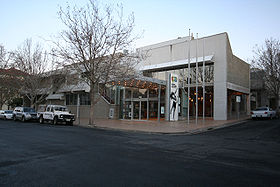
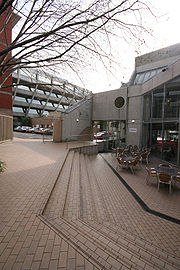
Geelong, Victoria
Geelong is a port city located on Corio Bay and the Barwon River, in the state of Victoria, Australia, south-west of the state capital; Melbourne. It is the second most populated city in Victoria and the fifth most populated non-capital city in Australia...
, Victoria
Victoria (Australia)
Victoria is the second most populous state in Australia. Geographically the smallest mainland state, Victoria is bordered by New South Wales, South Australia, and Tasmania on Boundary Islet to the north, west and south respectively....
, Australia. The centre has two major theatres, a number of smaller performance spaces, and a bar, restaurant and cafe. It is located between Little Malop and Ryrie Streets in central Geelong.
History
Proposals for a performing artsPerforming arts
The performing arts are those forms art which differ from the plastic arts insofar as the former uses the artist's own body, face, and presence as a medium, and the latter uses materials such as clay, metal or paint which can be molded or transformed to create some physical art object...
centre in Geelong were first made in the 1970s. The site chosen had a number of existing buildings upon it:
Temperance Hall
A TemperanceTemperance movement
A temperance movement is a social movement urging reduced use of alcoholic beverages. Temperance movements may criticize excessive alcohol use, promote complete abstinence , or pressure the government to enact anti-alcohol legislation or complete prohibition of alcohol.-Temperance movement by...
Hall was located on the corner of Little Malop Street and Aitchison Place. It was erected in 1858/59, the foundation stone being laid on 15 November 1858. This distinctive conservative classical building with Barrabool freestone facade, ornate central parapet entablature supported on Tuscan Doric pilasters and matching entrance portal was designed by an unknown architect for the Geelong Total Abstinence Society. The Hall was later used as a Grammar School in 1864. The hall was demolished in 1978 to enable the construction of GPAC. The stones were numbered and put into storage for future rebuilding, the current location being unknown.
Mechanics' Institute

Steeple Church
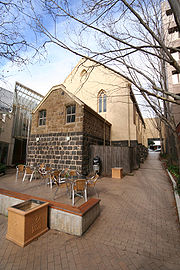
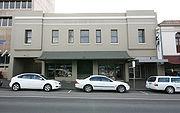
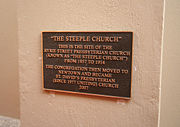
John Young
-Sports:* John Young , American baseball first baseman* John Young , English cricketer* John Young , English cricketer* John Young , soccer player...
in 1856 and built in bluestone in an Early English Gothic
Gothic architecture
Gothic architecture is a style of architecture that flourished during the high and late medieval period. It evolved from Romanesque architecture and was succeeded by Renaissance architecture....
style. In 1914 the congregation moved to Newtown
Newtown, Victoria
Newtown is an inner western suburb of Geelong, Victoria, Australia. It is a primarily residential area occupying one of the highest points of urban Geelong, has always been a desirable place of residence and it is the location of many of Geelong's oldest and most valuable properties.The locality of...
and became St. David's Presbyterian Church. The steeple was dismantled in 1913, and the present row of two-storey shops along Ryrie Street were built, although the main body of the church still exists today as part of the performing arts centre.
Arts Centre
Construction of the centre commenced in 1978 with the demolition of the Temperance Hall. The centre was designed in a BrutalistBrutalist architecture
Brutalist architecture is a style of architecture which flourished from the 1950s to the mid 1970s, spawned from the modernist architectural movement.-The term "brutalism":...
style with exposed concrete. It was officially opened in 1981, and consists of a number of separate venues:
- Ford Theatre: 797 seat proscenium arch theatre with dress circleAuditoriumAn auditorium is a room built to enable an audience to hear and watch performances at venues such as theatres. For movie theaters, the number of auditoriums is expressed as the number of screens.- Etymology :...
and fly tower. - Blakiston Theatre: 325 seat studioStudioA studio is an artist's or worker's workroom, or the catchall term for an artist and his or her employees who work within that studio. This can be for the purpose of architecture, painting, pottery , sculpture, scrapbooking, photography, graphic design, filmmaking, animation, radio or television...
-style theatre. - Alcoa Studio: 20.5m x 10m dance studioDance studioA dance studio is a space in which dancers learn or rehearse. The term is typically used to describe a space that has either been built or equipped for the purpose....
with a sprung floorSprung floorA sprung floor is a floor that absorbs shocks, giving it a softer feel. Such floors are considered the best available for dance and indoor sports and physical education....
, stage and mirrors. It is located in the former Steeple Church. - Ballet Studio 2: 15m x 9m dance studio with a sprung floor, ballet bars and mirrors. It is located in the upstairs area of the former Mechanics' Institute.
Sponsorship
In order to raise funds for the construction of the centre corporate sponsorship was sought. A number of Geelong companies pledged funds and had sections of the centre named after them. The main theatre was named after major sponsor FordFord Australia
Ford Australia is the Australian subsidiary of Ford Motor Company and was founded in Geelong, Victoria, in 1925 as an outpost of Ford Motor Company of Canada, Limited. At that time, Ford Canada was a separate company from Ford USA...
. The second theatre was named after Blakistons
Blakistons
Blakistons is a road transport and warehousing company founded in Geelong, Victoria, Australia in 1889.-History:The company supported many worthy causes in Geelong in the 1980s, providing funds towards a theatre at the Geelong Performing Arts Centre, and a new ward at the Grace McKellar aged care...
, a local local transport company; the main foyer after Shell
Shell Australia
In Australia, Royal Dutch Shell conducts a large range of activities. These include exploration for, and the production and commercialization of, oil and natural gas, the operation of two refineries, 19 terminals and 33 depots for the manufacture and distribution of oil products; and the marketing...
; and the courtyard after Alcoa.
Corporate sponsorship continues to support the running of the centre today.
Management
The Geelong Performing Arts Centre is a state owned cultural agency that receives funding through the financial assistance of the Victorian Government through Arts Victoria and the Department of Premier and Cabinet.The centre is managed by the members of the Geelong Performing Arts Centre Trust, which was established under the Geelong Performing Arts Centre Trust Act 1980. The trust is comprised by persons nominated by the local councils; experienced in the fields of education, business administration, finance or the performing arts; or having an active interest and leadership role in the performing arts.

